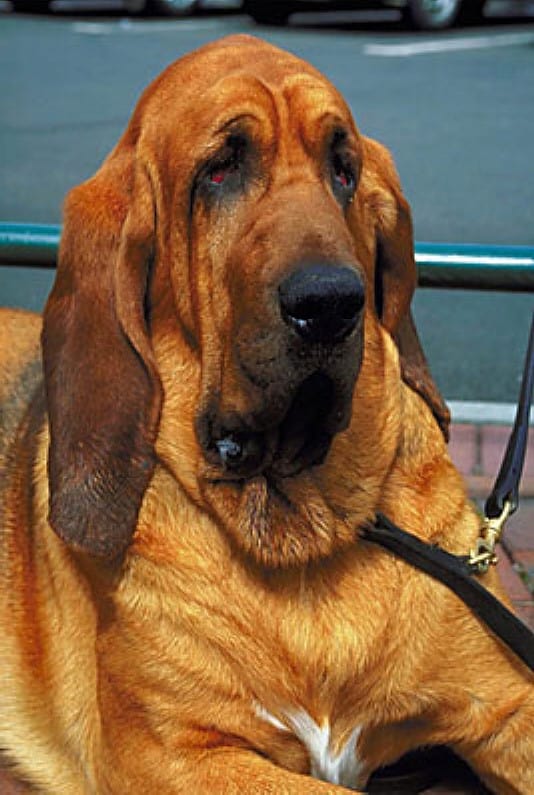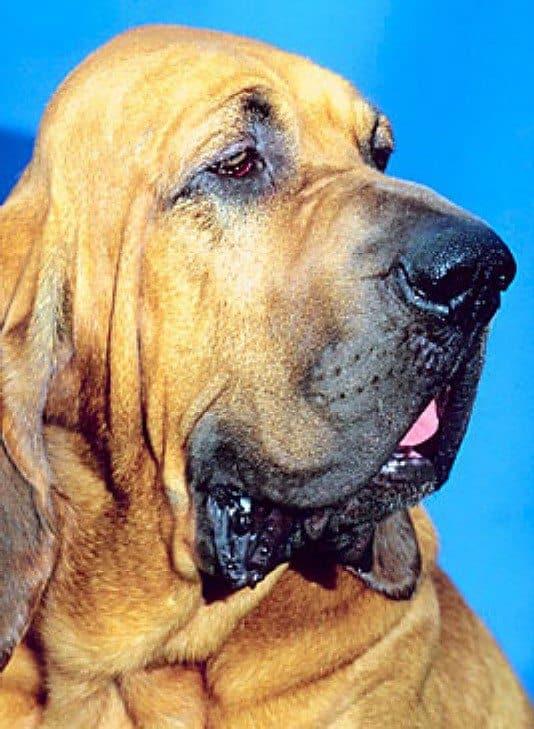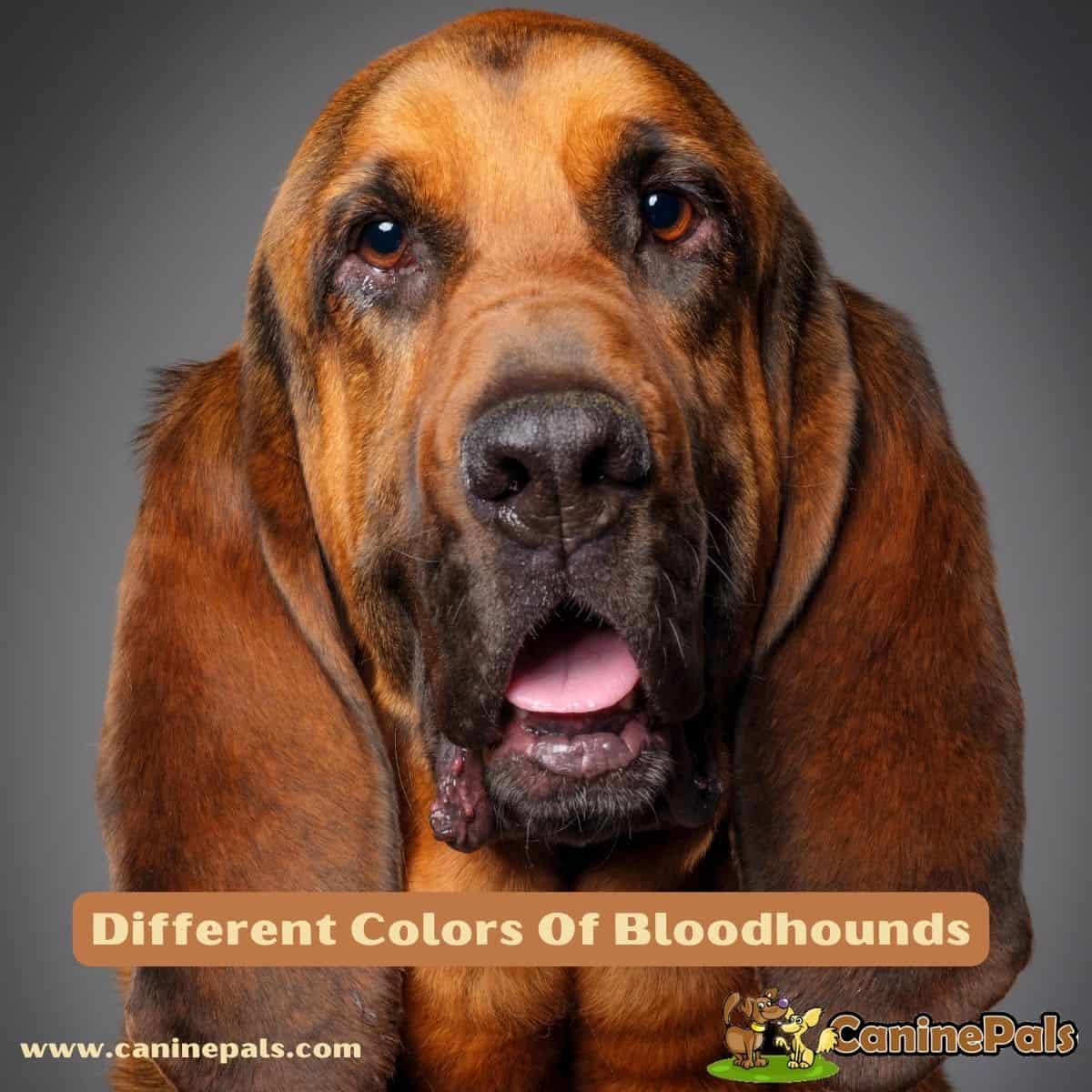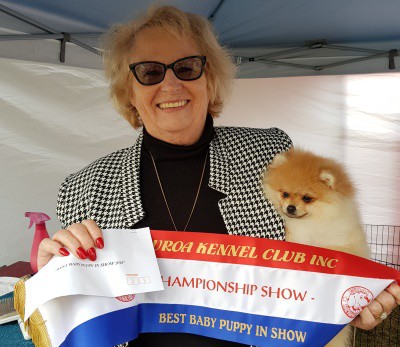Last Updated on March 8, 2024 by Denise Leo. Post first published on February 20, 2023.
Bloodhound dogs are descendants of noble ancestors. They are calm and loving dogs with varying coat shades. You can learn about the different colors Of Bloodhounds in this article.
Do you remember the old-school TV show character – The Droopy Dog? The features of a bloodhound dog breed inspired the character. Bloodhounds are physically large and strong dogs with calm and affectionate temperaments.
They are also known as St. Hubert hounds due to their splendid scenting ability. The scent-hunting breed of these dogs is derived from the St. Hubert stain. Law enforcement departments have used them as scent trail dogs during rescue operations.
The typical average weight of a bloodhound varies from 80 to 110 pounds with 23 to 27 inches of height. With short hair, drooping ears, deep folds in loose skin, wrinkled faces, and coats varying from the tones of black & tan to brown & red – bloodhounds are being used as police dogs due to their incredible sense of smell. When bloodhounds are on the scent, they follow their noses by dragging on the ground,
This guide will cover all you need to know about these scent hounds: bloodhound dog breed, history, personality traits, and physical appearance, including different colors of bloodhounds. But, first, let’s discover the aspects of this adorable dog.
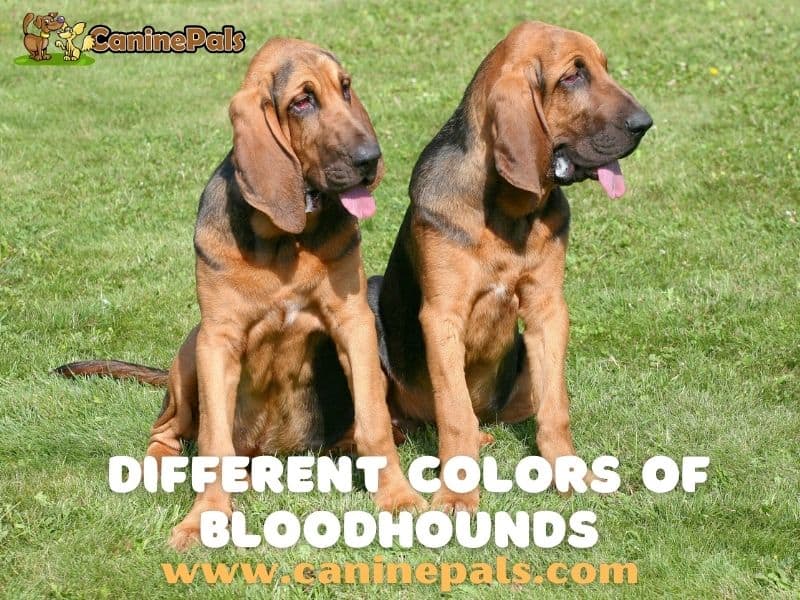
History Of Bloodhounds
The Bloodhound appeared in Europe well before the Crusades. Two strains were brought from Constantinople, white and black. They have been in America for over 100 years and immensely helped the police force, to the extent that evidence they discover is accepted in court.
This scent hound breed was known to discover and trace the tracks of animals from the first century A.D., which have now evolved as Bloodhounds. The early bloodhounds were called the Saint Hubert Hounds in the 7th century as the Saint Hubert of Belgium perfected this breed along with his monks.
A conqueror named William carried many bloodhounds with him when he arrived in England in 1066. That is why modern bloodhounds are known to have a noble history because they are derived from breeds belonging to royalty.
By the 16th century, this breed became a means to track deer for recreational purposes, and this practice evolved to track down missing people by law enforcement departments.
Bloodhounds were preferred to track missing people because they do not tear off their target after finding them due to their affectionate nature. Their nature could be why the poet Humphrey de Bohun used the name “Bloodhound” (pure blood) for these dogs in his poem for the first time in history.

Temperament Of Bloodhounds
Bloodhounds love to mingle with their family members as they are affectionate and playful. They look dizzy due to their droopy eyes but love being around kids and sharing their playful energy. Training adult dogs can be prolonged because they are naturally independent and stubborn. But their patience and mild manners conquer their persistent personality trait.
Socializing Ability
Bloodhounds have good socializing abilities, i.e., they quickly make friends with other dogs and small dogs and are tolerant towards kids. However, they are determined and may not obey your commands at times. For example, if a bloodhound has sensed a scent, he will follow it with complete determination without paying attention to his master’s command.
This breed can perform expressive whining and howling, an exciting aspect of their personality. In addition, they are dignified, docile, easy to make companions love to wander, and are good at reward training, friendly to strangers but bark up when they get excited.
Factors Affecting Temperament
Inheritance, training methods, and social habitat are the factors that affect their temperament. For example, too shy or playful breeds are difficult to train as their determined mind exceeds their instruction-following ability. So, a bloodhound puppy can be developed into an active, obedient, and gentle family pet.
Recognized Bloodhound Colors Patterns and Appearance
Bloodhounds typically stand 23 to 27 inches tall. However, males range from 90 to 110 pounds in weight, and females are between 80 to 100 pounds. With short and smooth coats, you will come across three different colors of bloodhounds:
- Black & tan
- Liver & tan
- Red
A speck of white can be seen on the chest, feet, and tail tip in significant strains. These Bloodhound coat color patterns are recognized as the following types:
- Blankets or Full coats
- Liver-pigmented
- Black-pigmented
- Saddle (predominantly black with little red)
Blanket and saddle types are seen in black and tan and liver and tan dogs. At the same time, red bloodhound breeds are seen in black-pigmented and liver-pigmented types (regarded as black bloodhound and liver bloodhound, respectively).
The variations in recognized Bloodhound colors, liver and tan, black and tan, and light to dark red, are determined by alterations in the black and brown genes. Black nose, black eye rims & paw pads will be seen in a Bloodhound if he inherits the black variant dominantly.

Which Habitat Does A Bloodhound Require?
Keeping a Blooded hound is challenging for Bloodhound owners. Because they are slow learners due to their determined nature, a bloodhound can be clumsy during adolescence and may follow unusual scents fearlessly. They also tend to chew things that smell different or bless their nose.
Following are the habitats of bloodhounds that you need to consider before keeping them:
- They can chew car seats, remotes, batteries, and towels because these articles smell different.
- A bloodhound ignores the caregiver on trails and outdoors if he smells an exciting scent. So roaming with a bloodhound requires a dog leash.
- They need good exercise. The typical lifespan of a bloodhound is ten years. If you get a puppy, you need to work on its activity, which promises a better quality of life.
- Long trail walks along with a leash are an essential part of their training so that they may develop a habit of listening to their guardian and develop required dependency. Also, bloodhounds tend to gain weight quickly. This makes walking a necessary health aspect for them.
- A calorie-restricted & balanced diet should be fed to a bloodhound as they are prone to get obese.
- Apartments are not a good place for this large breed. However, if you keep them in an apartment, taking them out daily to play is a good idea.
How To Groom A Bloodhound?
Following are the essential measures to groom your adult or puppy Bloodhound based on their wrinkled face, large body, drooping ears, and thick coat:
- Since the coat of the bloodhound is tight and thick, they shed moderately. So brushing them once a week aids in removing debris and dead hair.
- Bloodhound has wrinkles on its face and neck, which should be cleaned and dried regularly. As dirt and germs may reside and cause infection.
- Brushing should be done with a tool such as a rubber hound mitt. Bloodhounds seasonally shed hair, and sometimes you need a shedding blade to remove excess hair in the shedding season.
- The upper part of the lips drools in bloodhounds. So the mouth should be thoroughly cleaned after meals.
- The long ears of a bloodhound become home to dust and bacteria. So cleaning them once a week is necessary.

Is Bloodhound A Good Dog To Keep?
Bloodhounds are reliable companions and make great house pets because of their calm, loving, and good nature. They have a docile personality trait which is suitable for many dog lovers. Keeping a Bloodhound means you must keep them going with physical activities so they do not become lazy, and you keep finding them resting on the couch.
A home with children is a perfect place to keep a bloodhound; these dogs are kind to humans. Although they are difficult to train to their independent personality trait, their calm nature and controlled temperament make them easy to handle and be with.
Puppy training is best to start early rather than late as an adolescent, so puppy bloodhounds develop into obedient adults through early intervention. This breed possesses good energy, no matter how lazy they seem by their droopy eyes. They are always willing to play with and be around their family members.
Some Facts About Bloodhounds
Here are some interesting facts about this dog breed:
- We know that bloodhounds are great at tracking. But they were not named upon this ability. Instead, their ancestors went through noble acts of purity.
- The bloodhounds are trained to track missing humans and follow long trials by detectives and law enforcement agencies. They can follow the scents from miles away with very close accuracy.
- This dog breed can follow a scent even from 130 miles away. They have a tremendous smelling ability, but you should never test them without a leash.
- Bloodhounds can smell 300 hour-old scents and follow it on the track. This is an incredible and distinctive characteristic of this dog breed.
- The resting heart rate of a bloodhound is from 70 to 120 beats per minute which shows 40 times more capacity than a human heart rate of 70 to 80 beats per minute.
- These dogs don’t bark. They howl and produce a very different sound from their chest, called Bay.
- The coat of bloodhounds quickly gets greasy. They have a smooth texture on their fur to survive in the wild. Even though they are slippery and have not been cleaned for a long time, they still can actively follow a smell with incredible energy.
- Bloodhounds got extreme popularity after their portrayal in TV, and dog shows in the Victorian era. Since then, they have been great human companions and favorite dogs of many dog lovers.
- They consume four to eight cups of dry dog food daily in two divided meals.
- Bloodhounds have a habit of chewing. They may chew your household items, such as furniture and mattresses. Please do not keep them alone in the house outside their crate.
- They may sometimes develop anxious behaviors as they get bored quickly and crave attention.
- Exercise for 15 minutes a day is enough for bloodhound puppies. However, you can take them for long walks.

FAQs
Q. How smart are Bloodhounds?
Bloodhounds are an obedient and intelligent breed. Their smartness is known mainly due to their efficient scenting and tracking abilities.
Q. Do Bloodhounds make a good pet?
This breed is a great family pet. They are docile, playful, tolerable, and affectionate, especially towards kids. However, they need good exercise to stay energetic.
Q. Bloodhounds belong to which breed?
Hubert – a French monk of the 7th century, kept their ancestors for hunting purposes who were later named Saint Hubert hounds and evolved as Bloodhounds.
Q. What is the lifespan of Bloodhounds?
Bloodhounds can live from 10 to 12 years.
Q. What are the personality traits of bloodhounds?
They are calm, loving, and docile but independent and determined simultaneously. They follow attractive scents passionately, irrespective of their guardian’s command.
Q. How to play with a Bloodhound?
Take a ball with which your dog usually plays. Mark it and after applying a scent to the ball. Mix it with the other unscented balls and let your bloodhound dog find it passionately. This would be an excellent time for your dog to embrace its nature.
Q. What temperament do bloodhounds have?
They are calm but stubborn, affectionate but independent, and gentle towards family members and strangers.
Q. Do bloodhound dogs shed?
Bloodhound dogs shed moderately. Most of the shedding is seen seasonally during autumn and spring. The dense and short coat can be cleaned with a bristle brush once weekly to deal with bloodhound shedding.
Q. What colors do bloodhound dogs have?
Bloodhounds have three tones of color with a white patch on the feet, neck, or tail. The different colors of bloodhounds are Black & tan, Liver & tan, and varying shades of red.
Conclusion
Lastly, this is about the bloodhound breed born with incredible scenting ability and attractive personality traits. If you want to keep a bloodhound as your companion, follow a guide specifying its personality traits and training considerations.
The Bloodhound is a dog who will take charge if you let him. So you need to maintain your authority while giving him all the love and attention you can. He’s very affectionate and needs to be groomed regularly to feel, look, and smell good.
So, out of these different colors of bloodhounds, which color would you like in your bloodhound?
Copyright CaninePals.com. All Rights Reserved.
References and Further Reading:
[1] American Kennel Club, Bloodhound Information.

